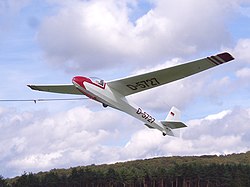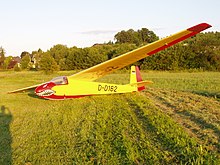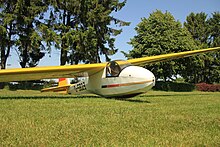Schleicher K 8
| Schleicher K 8 | |
|---|---|

|
|
| Type: | Glider |
| Design country: | |
| Manufacturer: | |
| First flight: |
5th November 1957 |
| Number of pieces: |
875 + 337 licensed buildings |
The Schleicher K 8 is a single-seat glider from the 1950s. The aircraft is designed as a shoulder- wing monoplane in a mixed construction. Due to its robust construction, the K 8 was and is mainly used for training beginners. A total of 1212 aircraft of the type were manufactured in various versions. The aircraft of the type K 8 are increasingly being replaced by gliders made of plastic. Nevertheless, the model is enjoying increasing popularity among friends of historical glider flying, among other things because of its low purchase price and easy repairability. Airplanes of this type are still present in many glider clubs for the same reasons.
The designation of the pattern is Schleicher K 8. Due to various circumstances, the K 8 is often incorrectly referred to as the Ka 8.
history

The K 8 was the eighth design for a glider by Rudolf Kaiser . Its first flight was in 1957. The aim of the design was a robust, simple single-seat practice glider for school and club operations. Only six of the original version of the K 8 were built, as a lack of aileron effect was found. In the successor version, the K 8 B, larger ailerons, a spring trim (from November 1958 optional Flettner trim ) and a sliding window were integrated in the canopy frame. The last version was the C series from 1974. The main features were an improved cockpit, a larger wheel with a diameter of 380 mm - located in front of the center of gravity - a shortened runner and larger- surface tail units . After around ten copies of the K 8 C, Schleicher discontinued production in favor of the much more powerful ASK 18 .
Up to the end of production in 1976, Schleicher 875 and under license from Schempp-Hirth as well as in amateur construction, a further 337 copies of all K-8 series - a total of 1212 pieces - were manufactured.
One example of this, the K 8 B of the Herford Aviation Association with the registration number D-5727 , was placed under monument protection as a movable technical cultural asset on May 21, 2011 . The 50-year-old "old lady" was built by the Herford aviation association, she was flown in in 1961 and has been in the association's flight operations ever since.
construction
The K 8 is a shoulder wing with ribbed wings, which are planked with plywood around the profile nose . The fuselage is a fabric-covered tubular steel construction. The chassis consists of a main wheel with a skid in front of it and a metal spur at the rear. The main wheel has a brake that is coupled to the airbrake lever . In addition, by pressing the stick when rolling out, the runner can be pressed onto the ground and thus an additional braking effect can be achieved. The large airbrakes extend up and down from the wings. Brake flaps, ailerons and elevators are driven by control rods, the rudder with steel cables.
Originally, the K 8 only had a very small, only partially glazed cockpit canopy. In later versions, a larger fully glazed hood - also known as the Swiss hood - was used, also through subsequent modifications. It can also be converted to an open hood.
Naming
The official name of the aircraft according to the flight manual is Schleicher K 8. However, the naming of the Schleicher aircraft often causes confusion. In the 1950s to 1960s in particular, the naming convention was changed at Schleicher and by the designer Rudolf Kaiser himself. In 1956 at the latest, Rudolf Kaiser was informed that his abbreviation “Ka” had already been used during the Second World War by the designer Albert Kalkert of the Gothaer Waggonfabrik . See for example: Kalkert Ka 430 . In 1966 at the latest, Alexander Schleicher expanded the designation to include the letters “AS” for Alexander Schleicher, which preceded the designer's abbreviation: ASK for A lexander S chleicher K aiser or ASW for A lexander S chleicher W aibel .
These circumstances ensured that the Ka 6 was registered as "Ka" in October 1955, followed by the K 7 without the "a" in September 1956. In the following years, various successors to the Ka 6, for example the Ka 6 C / CR (1959) or the Ka 6 BR-S (1963), were further provided with the Ka, while the K 6 E was largely a new development in 1965 without the a ”appeared. Various versions of the Ka 6 continued to appear with the old Ka nomenclature until 1963, when the K 7, K 8, K 9, K 10 and K 11 with the new nomenclature had already been approved in the meantime . The ASK 13 had its maiden flight in July 1966, but in April 1967 the K 12 appeared, which was later renamed ASK 14 . These circumstances make it difficult to assign the correct spelling to the individual sneak aircraft without precise knowledge of the literature.
The aircraft are usually pronounced with "K" and the associated number. The fact that there is no difference between "K" and "Ka" in German pronunciation makes it even more difficult to use the correct, written designation. These circumstances explain why the K 8 often appears as Ka 8 in addition to its official name.
present
The K 8 is an extremely light aircraft and is still used today in beginner training. In particular, students who started their glider training on a two-seater like the ASK 13 are sent off as the first single-seat aircraft after their first solo flights with the K 8. The K 8 is an uncomplicated and robust aircraft, like most of the aircraft types developed by the designer Kaiser, and it can withstand harder landings.
Due to its low weight, the K 8 climbs even in low thermal conditions and is even superior to modern plastic gliders in poor weather conditions. The distance flight performance, however, is comparatively modest.
Switching from two-seat training aircraft such as the Ka 2 or ASK 13 to the K 8 is easy, although it is much more manoeuvrable. The low demolition speed of 55 km / h is also remarkable .
Motor glider designs
K 8 B / Stihl
For the K 8 B existed a conversion kit comprising a Stihl - two-stroke engine (optional SK FL 120 6.5 PS or SK 120/137 FL with 7.5 hp) and a mandrel 72 - propeller . The engine could be attached to the tubular steel frame of the fuselage between the wings and removed again if necessary. A self launch was not possible with it, the launch was carried out in an airplane , car or winch tow . It was approved by the German Federal Aviation Office on June 30, 1960.
K 8 B / KM 48
At least one copy of the K 8 B was of Fichtel & Sachs (Schweinfurt) having a rotary engine of the type KM 48 equipped l, System NSU / Wankel and a fuel tank having a capacity of 5 avg. The engine, like that of the K 8 B / Stihl version , was reversibly mounted between the wings above the fuselage. This was the first rotary engine used in aviation, which developed 7 kW (10 HP) at a speed of 5000 rpm. It consumed around 2.5 l / h and weighed 18.5 kg with accessories. One example was equipped with this rotary engine in 1973 in the air sports club (LSC) Herne. This variant was discontinued after a few test flights because the flight performance did not meet expectations. During one of the test flights, the propeller broke and destroyed the wing covering in the immediate vicinity of the engine. Nevertheless, the K 8 B could be landed without any problems.
The German approval took place on September 16, 1960. The flight characteristics were described as almost unchanged compared to the non-motorized version. With the engine switched on, it could climb 1.0 to 1.5 m / s, but self-launch was not allowed.
Technical specifications
| Parameter | K 8 B | K 8 B / Stihl | K 8 B / KM 48 |
|---|---|---|---|
| crew | 1 | ||
| Passengers | 0 | ||
| length | 7 m | ||
| height | 1.58 m | ||
| span | 15 m | ||
| Wing area | 14.15 m² | ||
| Wing extension | 15.9 | ||
| Wing profile (inside / outside) | Gö 533 / Gö 532 | ||
| Max. Wing loading | 21.9 kg / m² | N / A | |
| Glide ratio | 25th | N / A | |
| Empty mass | approx. 190 kg | N / A | |
| Max. Takeoff mass | 310 kg | ||
| Maximum permissible load multiple | + 4 / −2 g | N / A | |
| Top speed (calm weather) | 190 km / h | 140 km / h | 150 km / h |
| Top speed (gusty weather) | 130 km / h | ||
| Top speed ( aircraft tow ) | 130 km / h | ||
| Top speed ( winch start ) | 100 km / h | ||
| Smallest sink at | 62 km / h | N / A | |
| Best glide at | 75 km / h | N / A | |
| Minimum speed | 55 km / h | N / A | |
| Stall speed | 52 km / h | N / A | |
| Engines | without |
Stihl SK 120 FL or SK 120/137 FL |
Fichtel & Sachs KM 48 |
See also
literature
- Peter F. Seliger: Rhön-Adler. 75 years of Alexander Schleicher glider construction. Publisher RG Fischer, Frankfurt a. M. 2003.
- Richard and Monique Ferrière: Les Planeurs et Motoplaneurs d 'Alexander Schleicher 1951–1981. Motorbuch-Verlag, Stuttgart 1988, ISBN 3-613-01190-5 .
Web links
- Alexander Schleicher GmbH & Co. Glider construction. In: alexander-schleicher.de. Alexander Schleicher, accessed March 23, 2009 .
- Gallery ( Memento from September 28, 2007 in the Internet Archive )
- K-8 fan page
- K-8 side
Individual evidence
- ↑ Alexander Schleicher: All types of aircraft since 1951 , accessed on December 18, 2018.
- ↑ a b c d single-seater from 1951 - gallery. K 8, B, C. In: alexander-schleicher.de. Alexander Schleicher , archived from the original on September 28, 2007 ; Retrieved September 5, 2011 .
- ↑ a b c Alexander Schleicher Segelflugzeugbau: Flight and operating manual for the glider type "K 8". Issue 15, November 1961.
- ↑ Ralf Nittner: Flying self-construction with a history . The "K 8 b" glider is Herford's first movable monument. In: New Westphalian . No. 119 , May 23, 2011 ( available online ).
- ↑ Flying memorial (certificate). Herford Aviation Association, 2011, accessed on June 3, 2017 .
- ↑ TM modification to open hood
- ↑ Peter F. Selinger: Rhön-Adler - 75 years of Alexander Schleicher Segelflugzeugbau, 2nd corrected and supplemented edition 2003, ISBN 3-8301-0554-1 , p. 76
- ^ Peter F. Selinger: Rhön-Adler - 75 years of Alexander Schleicher sailplane construction, 2nd corrected and supplemented edition 2003, ISBN 3-8301-0554-1 , p. 72
- ↑ Peter F. Selinger: Rhön-Adler - 75 years of Alexander Schleicher Segelflugzeugbau 2nd corrected and supplemented edition 2003, ISBN 3-8301-0554-1 , p. 89
- ^ Peter F. Selinger: Rhön-Adler - 75 years of Alexander Schleicher Segelflugzeugbau, 2nd corrected and supplemented edition 2003, ISBN 3-8301-0554-1 , pp. 62-107
- ↑ a b Luftfahrt-Bundesamt : Motor glider device identification sheet No. 670. Edition 2 of October 8, 1968, available online (PDF)
- ↑ a b c Luftfahrt-Bundesamt : Motorglider device identification sheet No. 691. Edition 1 of December 16, 1968, available online (PDF)
- ↑ Flug Revue September 1967, p. 8


